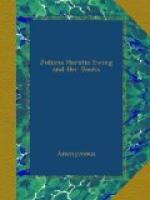Julie followed the course of the new lines in which her lot was cast most cheerfully, but the “mighty heart” could not really support the “little body”; and the fatigue of packing, combined with the effects of the relaxing climate of Bowdon, near Manchester, where she went to live, acted sadly upon her constitution. She was able, however, after settling in the North, to pay more frequent visits to Ecclesfield than before; and the next work that she did for Aunt Judy’s Magazine bears evidences of the renewal of Yorkshire associations.
[Illustration: SOUTH CAMP, ALDERSHOT.]
This story, “We and the World,” was specially intended for boys, and the “law of contrast” in it was meant to be drawn between the career which Cripple Charlie spent at home, and those of the three lads who went out into “the world” together. Then, too, she wished, as I mentioned before, to contrast the national types of character in the English, Scotch, and Irish heroes, and to show the good contained in each of them. But the tale seemed to have been begun under an unlucky star. The first half, which came out in the first six numbers of the Magazine for 1878, is excellent as a matter of art; and as pictures of North-country life and scenery nothing can be better than Walnut-tree Farm and Academy, the Miser’s Funeral, and the Bee-master’s Visit to his Hives on the Moors, combined with attendance at Church on a hot Sunday afternoon in August (it need scarcely be said that the church is a real one). But, good though all this is, it is too long and “out of proportion,” when one reflects how much of the plot was left to be unravelled in the other half of the tale. “The World” could not properly be squeezed into a space only equal in size to that which had been devoted to “Home.” If Julie had been in better health, she would have foreseen the dilemma into which she was falling, but she did not, and in the autumn of 1878 she had to lay the tale aside, for Major Ewing was sent to be stationed at York. “We” was put by until the following volume, but for this (1878) one she wrote two other short contributions,—“The Yellow Fly, a Tale with a Sting in it,” and “So-so.”
To those who do not read between the lines, “So-so” sounds (as he felt) “very soft and pleasant,” but to me the tale is in Julie’s saddest strain, because of the suspicion of hopelessness that pervades it;—a spirit which I do not trace in any of her other writings.
“Be sure, my child,”
said the widow to her little daughter, “that
you always do just as
you are told.”
“Very well, mother.”
“Or at any rate
do what will do just as well,” said the small
house-dog, as he lay
blinking at the fire.
* * * * *
“For the future,
my child,” said the widow, “I hope you
will always
do just as you are told,
whatever So-so may say.”
“I will, mother,”
said little Joan. (And she did.) But the
house-dog sat and blinked.
He dared not speak, he was in disgrace.




